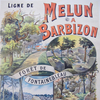Oorsprong, eenvoud en natuur. De bloeitijd van de kunstenaarskolonies, 1860-1910
DOI:
https://doi.org/10.18352/bmgn-lchr.6669Keywords:
cultural historyAbstract
Back to basics, simplicity and nature. The Golden Age of artists’ colonies, 1860-1910
During the nineteenth century, the Low Countries saw the rise of a large number of artists’ colonies in rural areas. The density of these colonies in the Netherlands and Belgium was the result of the marked contrast between the towns, which were gradually modernizing, and the seemingly unspoilt and completely traditional countryside. The colonies followed a standard pattern. The painters settled in villages in picturesque natural surroundings, preferably also with picturesque inhabitants, not too far removed from the main urban centres. An inn providing cheap lodgings was a basic requirement.
Often, a slightly older artist with paternal leanings acted as a benevolent host. The ideas behind the colonies usually consisted of a mixture of Utopian expectations, national and historical reminiscences, a longing for medical and spiritual regeneration, and a veneration of ‘nature’, both in the landscape and in the supposed innocence of the local inhabitants. In general, the colonies were soon overtaken by tourism and suburbanization.
Toward the end of the century, the accent came to rest more and more on experiments in lifestyle, and less on the arts as such. The ideologies of the fin de siècle aimed on the one hand to establish a new contact with ‘nature’, which was seen as a regenerative power, but on the other hand strove to overcome ‘nature’, which was also viewed as the source of baser instincts and the materialist aspects of life. This ambivalent conception of nature stimulated the founding of numerous colonies and at the same time made them superfluous, as the new spiritualism turned away from the visual representation of natural reality. The career of Piet Mondrian, a frequent visitor to several artists’ colonies, exemplifies this fundamental paradox.
This article is part of the special issue 'De menselijke canon en de Lage Landen'.
Downloads

Downloads
Published
Issue
Section
License
Authors who publish with this journal agree to the following terms:
a) Authors retain copyright and grant the journal right of first publication with the work simultaneously licensed under a Creative Commons Attribution 4.0 International (CC BY 4.0) that allows others to share the work with an acknowledgement of the work's authorship and initial publication in this journal.
b) Authors are able to enter into separate, additional contractual arrangements for the non-exclusive distribution of the journal's published version of the work (e.g., post it to an institutional repository or publish it in a book), with an acknowledgement of its initial publication in this journal.
c) Authors are permitted to post their work online (e.g., in institutional repositories or on their website) prior to and during the submission process.
Authors are explicitly encouraged to deposit their published article in their institutional repository.







